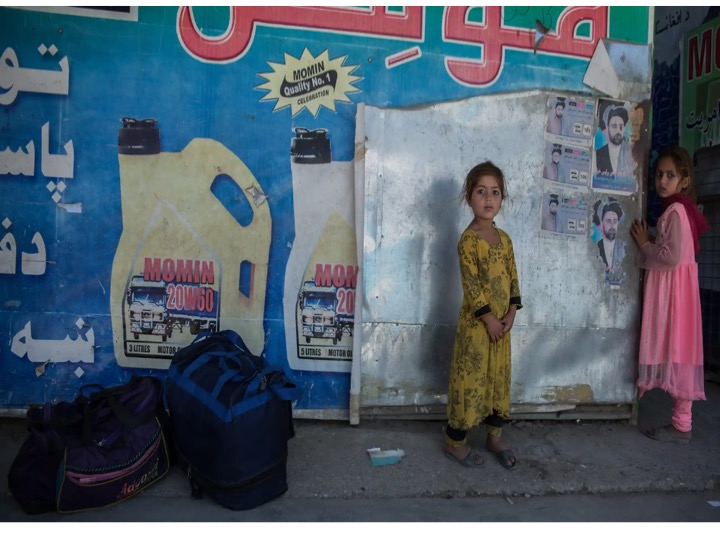'It's ripped families apart': the border wall no one is talking about

(Bill & Melinda Gates Foundation)Stefanie Glinski in Nangahar
Construction of a fence along the Afghanistan-Pakistan border, one of the world’s most dangerous crossings, is splintering families while failing to halt the flow of smugglers and terroristsGlobal development is supported by
Two children at the Turkham border, the official crossing point between Afghanistan and Pakistan. Photograph: Stefanie Glinski/The GuardianKeramat used to visit her sons all the time, crossing the border between her home in Afghanistan’s Kunar province into Pakistan, where they live and work.
But a fence built to mark a border between the two countries, which has not been recognised by the Afghan government, has made the 55-year-old’s journey much longer, and more bureaucratic.
Keramat had to get a passport, and needs a visa every time she wants to cross the border. She travels to neighbouring Nangarhar province, and from there she enters Pakistan. It can now take her several hours to cover a distance that used to take her less than one.
“My sons have worked in Pakistan for decades and we used to visit each other often. Now we barely spend time together. I miss them,” she says.
Walls and fences have been going up along borders across the globe, but relatively little attention has been paid to the one being erected along the Durand Line, the border between Afghanistan and Pakistan, considered to be one of the world’s most dangerous international crossings.
Plans for the 2,400 km-long barrier – mostly running along deserted high-mountain terrain – have been in motion for the past 15 years, but work on the fence is more recent, having started over the past two years. “We already finished 1,000km and it’s likely going to take another two or three years to complete the rest,” says Zahid Nasrullah Khan, Pakistan’s ambassador to Afghanistan.
The Durand Line was first established in 1893, but never recognised by Afghanistan. Relations between the two neighbours remain tense.
The fence, enforced with barbed wire and at times hesco blocks – a bulletproof wire mesh container filled with dirt – is surrounded by deep trenches and guarded by Pakistan’s border patrol.
Yet it’s not only the Afghan government that opposes the venture. Ethnic Pashtuns, who live on both sides of the Durand Line, are also protesting.
“It’s ripped our family apart,” says Keramat. “We’re the same tribe and the same people on both sides. We speak the same language and share the same culture. We’ve always lived together, but the fence is breaking families and friendships apart.”
About 28% of Pakistan’s population and 42% of Afghanistan’s are ethnic Pashtun – although Afghanistan’s last census was conducted nearly 40 years ago and it is estimated that numbers have increased.
But Khan says a physical barrier was needed because of increased security threats, and to put an end to smuggling activities between the two countries.
“The good old days are over,” he says. “The world is haunted by terrorists.”
At the same time, Afghans accuse Pakistan of fuelling violence and war in the country.
“It would be great if they [Pakistan] controlled the flow of terrorists, but that’s not what is happening,” says border police guard Ali Hamkar. “The fence creates problems for civilians. It doesn’t keep militants out – they still have their way. Pakistan built a wall, but they allow some unofficial gates.”
There have always been guards along the Durand Line, but Pakistan hopes the fence will make it possible to control the flow of people.
Ali Hamkar says one of the “unofficial” gates is located in Sobay village, in Nangahar’s Durbaba district. Durbaba is gun land. Villagers report that each man carries a weapon here, mostly for personal protection.
“Every night, the Taliban crosses the border here alongside hundreds of smugglers,” says Jani Gul, 35, a smuggler who crosses between Afghanistan and Pakistan’s Tirah Bazaar most nights.
He lives in a village with an economy largely dependent on illegal business. He smuggles electronics, clothes and occasionally drugs into Pakistan, while other people he knows bring weapons into Afghanistan.
Most smugglers cross the mountain terrain at night on mules, their goods strapped to the animals. Smuggling avoids paying Pakistani import tax and even though most goods come from China, it’s cheaper to ship them to Afghanistan first, where smugglers purchase them and sell them at a higher price in Pakistan.
Jani says that border guards on both sides are bribed. “I pay 1,500 rupees [$10] per mule and then they turn a blind eye.” According to the Pakistan and Afghanistan joint chamber of commerce and industry, about 20 smuggling gates exist along the border.
Haji Saraf, a 65-year-old who runs a smuggler’s union near Sobay, says that more people still cross into Pakistan unofficially compared with taking the legal route – despite the fence, including him.
“My daughter is married to a distant relative in Pakistan, and it’s the only way I visit her,” he explains from the union’s headquarters, a room furnished with pillows and carpets where he spends most of his time.
Khan insists the fence isn’t supposed to restrict the flow of ordinary people, and denies the existence of the smuggling gates.
“The tough part is that our tribal areas should have never been separated in the first place,” says Shakir Khan, 25, who recently returned to Pakistan after his brother’s death, marrying his widowed wife according to tradition. Economically, he says, there are differences between Pakistan and Afghanistan’s border areas, but when it comes to daily life, it’s largely the same.
“I have relatives with Pakistani passports and others with Afghan passports. Here in this area, we’re the same people and international borders won’t change this.”
|